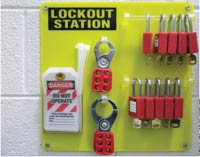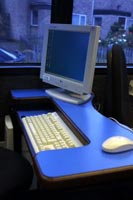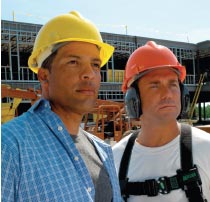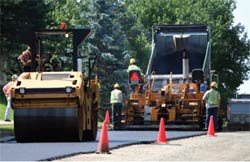
March 2008
- Send the Protection Message Loud and Clear
- Safety, Health Incentives: A Holistic Approach
- Enhacing Safety Before Breaking Ground
- Beware the Sliding Program: LOTO
Click here to subscribe.
Features

By Linda J. Sherrard
Severe burns from steam. Electric shock. Death when a machine cycles and a worker is caught and mangled. Burns. Destroyed and or disrupted lives of family. Damaged or destroyed equipment. Lost productivity. Add to all of these those dollars by the thousands that are paid out in worker’s compensation claims. Yet every day, somewhere, there is a lockout/tagout program beginning to slide that will result in some employee’s being injured or production’s being adversely affected.
By Dan Hoemke
Incentives have arrived. That’s stating the obvious when you consider American companies spend $32+ billion annually on merchandise sales for a variety of rewards, recognition, and motivation programs.

An earnings conference call and webcast Feb. 12 gave investors in NeuroMetrix Inc. (Waltham, Mass.) an update on the company’s continuing efforts to overcome reimbursement challenges facing its NC-stat nerve conduction testing device, which is used by thousands of doctors to diagnose Carpal Tunnel Syndrome cases. Our special report includes an interview with a Florida hand surgeon who uses the device and advice for optimizing computer workstations by 3M Workspace Solutions consultant and Certified Professional Ergonomist Thomas J. Albin.
By Michael Behm, CSP, Thomas Kramer, Kimberly Messer
Although the concept of proactively creating safe construction sites is widely agreed upon, achieving this reality has been traditionally lacking in execution. By combining the knowledge of professionals in both the construction and design facets of a project, safety can be enhanced before crews ever break ground. Doing this will yield a positive impact on not only worker safety, but also quality and productivity. Costs are lowered, task performance is improved, and life-threatening work hazards are reduced.

By Renee S. Bessette
You don’t have to go far in any city or along an interstate highway to hear the sounds of new construction— office buildings, hotels, restaurants, shopping centers, and houses. And just as you can hear the loud sounds of cranes, pile drivers, nail guns, and jackhammers, so, too, can the workers who are raising these structures. In fact, it’s a lot louder for them. Are they wearing hearing protection? In many cases, the answer is no.
Every safety program has the opportunity and responsibility to review selection, use, policy, and follow-up and to make those changes needed right now.
By Linda J. Sherrard
Few of us can imagine losing our hearing or vision, or the physical recovery from facial damage from an injury and the hardships this loss would cause to the injured or his/her family and relationships—from time, bills, and potential lost earnings alone. Yet these injuries are very common at the workplace and sometimes are shrugged off as the cost of getting the job done by employees and supervisors alike. What can we as safety leaders do to help drive home the message of always wearing appropriate PPE? And how can we keep our efforts on the front burner with upper management?

By Randy DeVaul
High humidity and high temperature are the key ingredients for a recipe of disaster if the body is not properly prepared to handle a hot environment. Whether exposure is a result of regular employment (such as in a foundry, steel mill, or other heated environment), fluctuating seasonal temperature changes (heat waves during the summer), or abruptly changing environments (such as vacationing or business travel), heat stress conditions can have a serious impact on one’s health and well-being.
Departments
By Bruce Oliver, Jim Dillingham
Facilities that operate across multiple shifts face a significant challenge when it comes to maintaining the alertness of their employees. According to the National Sleep Foundation, "Sleep deprivation is greatest among shiftworkers, who average only 6.5 hours of sleep compared to 6.8 hours for people on regular '9 to 5' work schedules and 6.9 hours for all respondents."
By Jerry Laws
Work on an offshore oil or gas rig presents many hazards. Getting out there can be dangerous, too, because of sea and weather conditions. Helicopter transport has a good safety record, but even the United Kingdom Offshore Oil and Gas Industry Association Ltd, which claims to be the world leader in offshore helicopter safety, has experienced two fatal crashes, with 18 deaths, in the past decade.
By Marc Barrera
The Chinese philosopher Confucius once said, “I hear and I forget. I see and I remember. I do and I understand.” This ancient proverb seems even more appropriate when dealing with safety and safety training. So many choices are available— including audio, video, written materials, and personal instruction. The Australia-born VoiceMap™ system created by behavioral scientist Maggie Haertsch, Ph.D., combines all of these elements into one to deliver a customized training program that not only instructs trainees, but also gets them actively involved in the lesson.
By Jerry Laws
Safety, productivity, alertness, and quality are tightly linked with job satisfaction. But does this mean state governments should ensure a “living wage”?